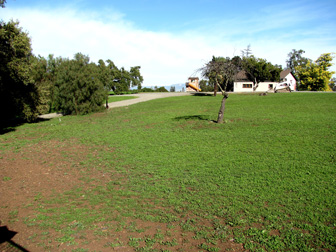Isenberg ("EE-zen-berg") is a distinguished old name,
not only in the San Francisco Bay Area but in Western United States,
including Hawaii. The family founder was Paul Isenberg, born in
Dransfeld, Germany in 1837, to a Lutheran clergyman father. Paul
was well-educated, but had to work hard on a local estate where
he learned farming and bookkeeping. About 1860 he was sent by
one Herr Hoffschlaeger of Hanover, possibly a family friend, to
Kauai, Hawaii, to work a farm property. He moved on to manage
an unprofitable sugar plantation in Lihue which he made profitable.
Before the plantation's owner Mr. Rice died, Paul had married
his oldest daughter Hannah Maria. They had two children, but Hannah
died in 1867. Paul returned to Germany, remarried a Miss Beta
Glade, and returned with her to Lihue in 1869.
 Paul
Isenberg prospered in Hawaii. He expanded the Lihue plantation
and invested in others. In 1881 he became a partner in the firm
of H. Hackfeld, a major sugar refiner and exporter. He returned
to Germany regularly, and died in Bremen in 1903. Paul and Beta
had six children. Of these, their son Heinrich Alexander was most
involved in the family Hawaiian properties. In 1895 the San Francisco
Call announced the engagement of Alexander, of Honolulu, to
Miss Virginia Duisenberg. Their marriage was in keeping with Alexander's
German roots, Virginia being the daughter of the late German consul
Charles Duisenberg. Alexander continued the family's international
involvement, being designated German consul for Hawaii in 1903
by President Theodore Roosevelt.
Paul
Isenberg prospered in Hawaii. He expanded the Lihue plantation
and invested in others. In 1881 he became a partner in the firm
of H. Hackfeld, a major sugar refiner and exporter. He returned
to Germany regularly, and died in Bremen in 1903. Paul and Beta
had six children. Of these, their son Heinrich Alexander was most
involved in the family Hawaiian properties. In 1895 the San Francisco
Call announced the engagement of Alexander, of Honolulu, to
Miss Virginia Duisenberg. Their marriage was in keeping with Alexander's
German roots, Virginia being the daughter of the late German consul
Charles Duisenberg. Alexander continued the family's international
involvement, being designated German consul for Hawaii in 1903
by President Theodore Roosevelt.
Alexander and Virginia had two sons, Rudolph, born in San Francisco
in 1899, and Alexander the younger. Alexander the father, however,
contracted pneumonia while just in his 30s and died. Virginia
returned to San Francisco, where she lived the rest of her life
when not traveling, which she did extensively. She had a house
in Munich, Germany, San Francisco, and Honolulu. Her sons had
peripatetic childhoods: their mother dragged them all over the
world. They were taken out of school to be educated by private
tutors while traveling, although Rudolf did attend the Thacher
School in Ojai, California, and the boys were sent east to prep
schools. The constant moving about seems to have permanently affected
Rudolph. He moved his whole life, from place to place and from
business to business. Additionally, he changed his name, dropping
the d from "Rudolf" to make it "Ruolf."
About 1922 Ruolf and his family had a visitor, his cousin Gerda
Isenberg. Gerda's father Carl, Alexander Isenberg's brother, had
an estate called Travenort, near Lübeck in Northern Germany
near Bremen. He was what we might call a gentleman farmer: educated,
as was his wife Martha, Gerda's mother, and appreciative of the
arts. Gerda, born 1901, was educated partly at home and partly
at a school near her grandmother's home in Bremen. She was generally
unenthusiastic about school until age 16, when she was sent to
what was called a "garden school" - named Gross Hansdorf.
Ordinarily young girls of Gerda's background would be sent to
a finishing school, often in Switzerland, but World War I was
raging. A generation of young men was at war being wiped out,
leaving raising food to the women. Gerda was sent to garden school
partly out of necessity. The climate was bad and the food was
very plain, but Gerda loved her time there, better than she would
have loved any finishing school. She was good-looking and independent-minded,
particularly for a German Empire girl.
Ruolf asked Gerda to marry him and stay in Hawaii. "I don't
think so," she said. She didn't want to leave Germany, even
though it was in terrible shape post-World War I. Besides, the
United States and Germany had just been at war, and Americans
were prejudiced about Germans: they "all drink beer and are
obnoxious and fat." Germans on the other hand considered
Americans uncultured, interested only in money. Ruolf persisted.
After Gerda returned to Germany Ruolf went also, staying with
an uncle. Gerda's parents were skeptical of Ruolf: true, he had
money, but he had no steady employment. Ruolf's answer was to
go back to California and buy land in Carmel Valley. With the
help of Japanese farm workers, Ruolf began raising strawberries,
which gave the impression of stability. Ruolf told Gerda he wanted
to go into farming, which was fine with her. They were married
in 1923 and came to live in Carmel Valley. Gerda's parents visited
later; they were not happy with the spot.
 Ruolf
never stayed in one place too long. When Gerda was pregnant with
their first child, he sold the Carmel Valley property to a member
of the Lowell family, as in Lowell Observatory, Flagstaff, Arizona.
They had four children: Dorothea Martha, Gerda, Carl Alexander,
and Anne Marie ("Ami") (Gerda & kids). In 1928 the
family moved to what is now Los Altos Hills, and built a house
at Old Trace Lane at Fremont Road.
Ruolf
never stayed in one place too long. When Gerda was pregnant with
their first child, he sold the Carmel Valley property to a member
of the Lowell family, as in Lowell Observatory, Flagstaff, Arizona.
They had four children: Dorothea Martha, Gerda, Carl Alexander,
and Anne Marie ("Ami") (Gerda & kids). In 1928 the
family moved to what is now Los Altos Hills, and built a house
at Old Trace Lane at Fremont Road.

Palo Alto city directories in the 1930's list Alexander Isenberg
as manager of the Durant Insulated Pipe and Manufacturing Company,
Palo Alto, residence Los Altos.
Ruolf was mechanically inclined, and among his many pursuits
was aviation. The Isenberg property, between Old Trace Lane and
Altadena Drive, was large and relatively flat. In the 1930's Ruolf
laid out an airstrip for use by himself and a few friends.
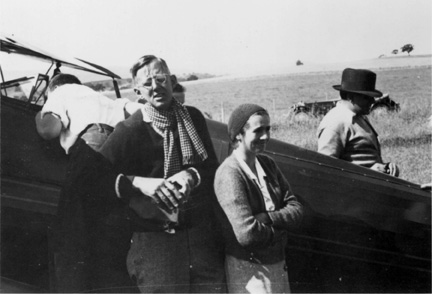
The airstrip had just one building, possibly from when the property
was a chicken farm. The strip was unpaved, as was common then.
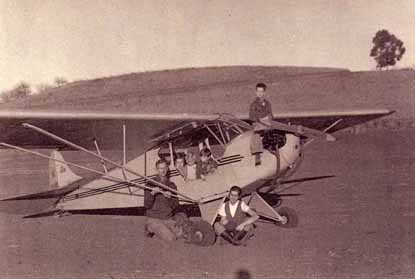
We see the whole family here, Ruolf, Gerda, and their four children
with one of Ruolf's aircraft. Ruolf is also credited with helping
establish the Palo Alto Airport.
Ruolf and Gerda lived at the house in what is now Los Altos Hills
until 1941, when Ruolf got into another business. At a feed store
he met a man named Langley, whose father had homesteaded a large
property, about 3,000 acres, on the west side of Skyline Boulevard,
to raise cattle. Langley the son built a house, but the venture
did not last, and he was ready to sell. Ruolf, having a substantial
fortune, bought the property intending to raise beef cattle -
interesting for a vegetarian. In 1944 the Los Altos property was
sold to Dr. Esther Clark, a pioneer pediatrician and sister of
Birge Clark, the architect whose designs are everywhere in Palo
Alto. Dr. Clark later sold the property for a reasonable price
to the City of Palo Alto. It is now Esther Clark Park, which is
unimproved, no facilities, just paths. The airstrip is now mostly
overgrown but can be visualized.
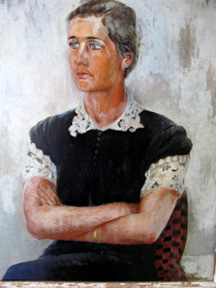 The
Isenbergs maintained residences in Palo Alto, first on Cowper
Street, then on Webster, so the children could attend Palo Alto
schools. We see here a portrait of Gerda by the Russian artist
Victor Arnautoff, who was supervising artist of the frescoes in
San Francisco's Coit Tower. With her children growing, Gerda cast
about for things to do. In the early 1930's Dr. Gertrude Zenzes,
a German woman friend, remarked that there was no German bookshop
in San Francisco. Gerda took the opportunity to open one. Her
father having set up a trust for her, she went back to a book
wholesaler in Leipzig, Germany, placed an order, and had it shipped
out. An initial location on 609 Sutter Street being unsatisfactory,
they moved into another location on Sutter near Mason. There was
a reading room and tearoom on the mezzanine. Gerda's parents came
out, thought the bookshop was wonderful, and sent back some paintings,
which were unfortunately incompatible with the décor.
The
Isenbergs maintained residences in Palo Alto, first on Cowper
Street, then on Webster, so the children could attend Palo Alto
schools. We see here a portrait of Gerda by the Russian artist
Victor Arnautoff, who was supervising artist of the frescoes in
San Francisco's Coit Tower. With her children growing, Gerda cast
about for things to do. In the early 1930's Dr. Gertrude Zenzes,
a German woman friend, remarked that there was no German bookshop
in San Francisco. Gerda took the opportunity to open one. Her
father having set up a trust for her, she went back to a book
wholesaler in Leipzig, Germany, placed an order, and had it shipped
out. An initial location on 609 Sutter Street being unsatisfactory,
they moved into another location on Sutter near Mason. There was
a reading room and tearoom on the mezzanine. Gerda's parents came
out, thought the bookshop was wonderful, and sent back some paintings,
which were unfortunately incompatible with the décor.
In the middle 1930's Gerda began another involvement. In the
United States just after World War I she had heard stories about
German atrocities - cutting off the hands of Belgian children,
etc. - which she had dismissed as exaggeration. During a trip
to Germany in 1933 or 1934, however, she found a strange atmosphere.
People discussed politics - Hitler, in other words - only with
close friends or relatives; never where a stranger could overhear
them. If a servant appeared, the conversation stopped; he or she
might be an informer. Back home in Los Altos, Dr. Esther Clark
called Gerda to tell her about Dr. Arthur Haim, a German Jewish
doctor who had escaped Germany just as he was about to become
a professor in Hamburg, leaving his fiancée behind. Josephine
Duveneck, a close friend, said there should be a center in San
Francisco for refugees, many of whom had escaped the war in Europe
by crossing Russia, Japan, and the Pacific. Gerda, who spoke German
of course, began going to the American Friends Service committee
in San Francisco. She was sent to visit refugees who had recently
arrived and needed advice or just a welcome. She also joined the
Society of Friends.
After the Imperial Japanese Navy bombed Pearl Harbor and the
United States entered World War II, Gerda worked on behalf of
Japanese Americans who were threatened with what was euphemistically
called "relocation," that is, forced evacuation into
concentration camps on the grounds that they were disloyal aliens.
As Gerda put it:
I was also quite conscious of any civil rights problems,
especially after what happened in Germany. Having taken a position
against the country of my birth during World War II, I was not
going to let an action which was contrary to human rights by
the government of my adopted country go by without at least
giving some assistance to the people in question. My stand on
the basis of human rights made me sensitive to anything that
might be done in the way of disregarding human rights in the
U.S.A.
The Isenbergs had two Japanese-American girls working for them
at the ranch property off Skyline Boulevard, which along with
their German background, put them under suspicion. One day after
Pearl Harbor Ruolf drove up to the property as a car was coming
back up the road with two men in it. Thinking they were salesmen,
he said "I'm on my way home. Make it short." The men
showed him FBI badges. They were investigating a rumor: Josephine
Duveneck's husband Frank had given Gerda some cots that weren't
needed at the Duveneck's property, Hidden Villa. Supposedly they
were to be used for an invading Japanese army. The agents had
searched the house and found a suspicious radio that might have
been used for sending messages. The Isenbergs managed to send
the Japanese girls to Philadelphia so that they wouldn't be "relocated."
Several prominent citizens, including Josephine Duveneck, Stanford
University President Ray Lyman Wilbur, and University of California
President Robert Gordon Sproul, lent their names to the American
Committee for Fair Play, which lobbied Washington on behalf of
Japanese-Americans. In 1944 Gerda, and Josephine Duveneck, traveled
on behalf of the committee to the relocation camp at Tule Lake,
California, which was where supposedly pro-Japanese Empire, disloyal
Japanese-Americans were held. Gerda shared with them her difficult
feelings about being German by birth, and the same time wanting
Germany to lose the war.
Post-World War II, Gerda continued liberal activism. In 1945
another committee, the Palo Alto Fair Play Council, was founded
at her house, its purpose being to assist Japanese-Americans in
getting re-established after returning from the camps. Housing
was a particular issue. In 1950 the Fair Play Council developed
a plan that was radical for the period, a racially integrated
housing tract. Members of the council contributed down payments
to purchase about 25 lots. Paul Lawrence, an African-American
student at Stanford, was contact with the City of Palo Alto planning
commission. The subdivision was later named the Lawrence Tract.
There were of course hostile reactions from local whites. Gerda
got some unpleasant phone calls. She felt that the project, while
small, definitely proved something. In 1950 she ran for the state
assembly 28th district seat on the Democratic ticket, but lost.
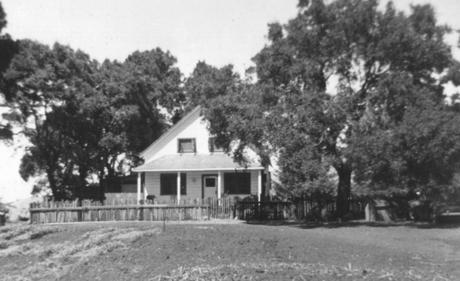
The house, built in 1905, on the property on Skyline Boulevard
that Ruolf bought in 1941, was uninhabitable: woodrats, mice,
and bats had to be cleared out; there was no indoor plumbing and
no power. After cleaning up and installing plumbing, the family
moved in, cooking outdoors while waiting for PG&E to hook
up. Ruolf Isenberg built an addition and living room. The house
accommodated the Isenbergs' four children, an Isenberg niece,
and a refugee boy from Germany. Besides Ruolf and Gerda there
was a music teacher, one Marion Edwards. Ruolf built a road to
the property. Ruolf's interest in the property, however, did not
endure, nor did the Isenbergs' marriage. They divorced in the
1950's and divided the property, after which Ruolf married Ms.
Edwards. Gerda had little money, but there was a quarry on the
property. It was leased to a man named Dempsey, but took several
years to become profitable.

The property had meanwhile revived another interest of Gerda's.
When her children were small the Isenbergs had gone often to Lake
Tahoe, where she was fascinated by conifers and other native California
plants. In 1955 Gerda decided to start a own nursery, devoted
to California native plants. Fittingly, it was called Yerba Buena,
derived from the old Spanish term meaning "good herb."
(Yerba Buena was the original name of San Francisco.) There was
little interest in native plants at the time; they were considered
weeds. Gerda began by propagating ferns from spores. Demand eventually
grew, until Yerba Buena, the first nursery of its kind in California,
became successful. Bart O'Brien, who became manager in 1988, said:
Yerba Buena Nursery has long been an important source of
native plants for the Bay Area, and an invaluable way station
in many lives. Over sixty people have been enriched by their
experience as employees, volunteers, or interns at Yerba Buena
Nursery. A reward of equal or greater value than the horticultural
knowledge and experience to be gained…is the opportunity
of getting to know Gerda. Her wit, wisdom, and life history
are rich sources of inspiration to everyone.
In 1990 and 1991 Gerda was interviewed by Suzanne Riess of the
Bancroft Library, University of California, Berkeley, Oral History
Series. In 1995, when Gerda was 94, the nursery was sold to David
and Kathy Crane of Woodside. Gerda lived in her daughter Ami's
house, about a mile west of the nursery. Sunday, June 8, 1997,
was Gerda Isenberg Day at Yerba Buena Nursery, a combination 96th
birthday celebration and dedication of a native plant garden.
Immediately afterwards Gerda suffered a stroke, and died the following
Wednesday.
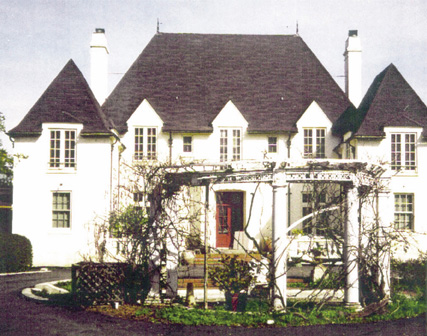 Early
Los Altos Hills was a farming and orchard community. Some farms
built substantial manor houses. In 1914 Palo Alto realtor William
Cranston bought a 20-acre parcel of land in Los Altos Hills at
what is now the corner of Fremont Road and Campo Vista Drive.
Early
Los Altos Hills was a farming and orchard community. Some farms
built substantial manor houses. In 1914 Palo Alto realtor William
Cranston bought a 20-acre parcel of land in Los Altos Hills at
what is now the corner of Fremont Road and Campo Vista Drive.
The property included a big red barn and an old shingled farmhouse,
which was called the Red Barn House. Two Cranston children, daughter
Ruth Eleanor and son Alan - who would become United States Senator
from California - roamed the area in childhood.
In 1922 the Cranstons sold the property to Dr. C.C. Crane. Crane
demolished the old farmhouse and erected an elaborate manor 8,000-square
foot manor in the style of a French chateau (Winbigler-House).
In 1946 Donald Winbigler and his wife Mary Elizabeth, a professional
classical Spanish dancer, purchased the property. Winbigler was
born in Illinois in 1909. After graduating from Monmouth College
in 1931 he earned a doctorate in speech and drama at the University
of Iowa, and came to Stanford as an assistant professor in 1940.
In 1945 he was appointed Registrar by Stanford University President
Donald Tressider. In 1950 he was appointed Dean of Students, a
position he held during the tumultuous 1960's. Winbigler was known
for being fair-minded to all sides, and presided over basic changes
in the university-student relationship. The Winbigler House, as
it became known, and the surrounding property, with an apricot
and plum tree orchard, became a popular subject for local artists.
Neighborhood children supposedly called the house "The Castle."
After Winbigler's wife died in 1998, he moved to the State of
Washington to be near his son Myles. In 1999 the Winbigler House
was sold for $4 million to Silicon Valley entrepreneurs Gordon
Campbell and Maria Legeti. In the year 2000 Campbell and Ligeti
applied to the Town of Los Altos Hills Planning Commission for
permission to remodel and renovate the Winbigler House. A permit
was granted, subject to conditions. A letter dated September 19,
2000, to the owners from Planning Director Carl Cahill stated
"The existing home shall not be moved, relocated or demolished
without prior site development review and approval by the Planning
Commission."
In 2001 Los Altos Hills residents saw that the stately Winbigler
House had been moved off its old foundation and was sitting on
jacks. The original foundation was being replaced by an expanded
basement and 5-car garage. Architect David Bogstead, Walnut Creek,
said the old foundation was not seismically safe, and was musty.
He assured residents that "The overall goal is, when it's
done, it looks like it's always been there." Additionally,
two-story would will be attached to the house's sides and rear.
Other additions included a caretaker's residence, a studio-workshop,
swimming pool, and tennis court. The new structure might comprise
36,000 square feet.
In August, 2002, residents were even more startled. Although
the permit was for incorporation of the house into the new design,
the Winbigler House was demolished instead. Demolition became
a cause célèbre. Planning Director Cahill issued
a stop-work order immediately after learning of the demolition.
Residents blamed Town Council members for being negligent, turning
a blind eye to such demolition, as it would be easy to get permission
for a fait accompli. Mayor Bob Fenwick responded that there was
no such policy. Ligeti and Campbell tried to minimize the matter.
In one of their earliest public responses, Ligeti said she had
simply overlooked the $52 demolition permit; and the new structure
was to be a reproduction of the original one. Besides, the house
could not have been saved. Walls were buckling, she said, and
there was dry rot and termite damage. As the alternative to building
a whole new structure would have been subdivision, she said "We're
doing a great service to the community."
On September 12, 2002, by unanimous vote, Los Altos Hills planning
commissioners levied a fine of $27,000 on Campbell and Ligeti,
accusing them of arrogance for tearing down the Winbigler House.
Ligeti deflected the matter as insignificant, compared with what
was going on the rest of the world - the September 11, 2001 attacks;
AIDS; the possibility of war in Iraq. "This ain't a big problem."
It wasn't a demolition, but "a reconstruction disassembly."
She said it was all just a procedural mistake that she hadn't
gotten a demolition permit; it was far from clear, however, that
she would have gotten one. Ligeti and Campbell had supposedly
wanted to show the commission rotten timbers from the old house,
which justified why it couldn't be saved, but didn't. The matter
was complicated by an impending local election. Bill Kerns, a
candidate for Town Council, called the demolition "a blatant
betrayal…of the community's trust." Townspeople overwhelmingly
denounced the demolition. Other actions by the Planning Commission
included denying a site development permit and a review of building
inspection documents to determine why staff hadn't seen the demolition
coming. The city attorney was directed to see if the architect
could be barred from working in Los Altos Hills.
On December 19, 2002, after an appeal by Ligeti and Campbell,
the Los Altos Hills Town Council voted 4-1 to uphold the Planning
Commission's actions. In 2003 construction began at the site of
a new structure, 45 feet higher than the original. Then it stopped.
The property was sold to Pinewood School, which applied in October
2004 to remove the unfinished structure. Pinewood School's new
quarters were never built, however. We see the property here today.
